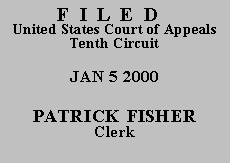

| UNITED STATES OF AMERICA,
vs.
GREGORY C. WOMACK |
|
In July 1997, police found the remains of a drug laboratory in a salvage yard in Oklahoma City. Upon investigation of the site, they discovered envelopes addressed to a certain apartment on 10th Street in Oklahoma City. Police investigated the apartment where they apprehended Gregory Womack, as well as other codefendants. Mr. Womack was found to be in possession of marijuana, methamphetamine and cocaine. Tr. at 27.
Mr. Womack argues that there was insufficient evidence for the trial court to find that he was an organizer or leader of the conspiracy and enhance his sentence by four levels under USSG § 3B1.1. "We review the district court's conclusion that a defendant is a leader or organizer under § 3B1.1(a) for clear error." United States v. Tagore, 158 F.3d 1124, 1130 (10th Cir. 1998).(1)
Application note 4 to § 3B1.1 sets out various factors that a court should consider in determining whether an individual is an organizer or leader under the guidelines. See USSG § 3B1.1, comment. (n.4). These include decision-making authority, recruitment of accomplices, right to a larger share of the fruits of the crime, degree and nature of participation in planning and commission of the offense, scope of the illegal activity, and degree of control over others. At sentencing, the district court specifically noted:
In this case, I have no question but that the evidence abounds that Mr. Womack . . . was the leader and organizer of an extensive conspiracy involving well more than five people. Specifically, he chose the sites; he either provided the precursor chemicals or directed others where and what to get; he profited more than the others; he directed sales as well as manufacture.
Sentencing Tr. at 9. The evidence in the record supporting this finding is substantial and there was no error.
Mr. Womack argues that the court erred in sentencing him under the 1998 version of the Sentencing Guidelines (effective November 1, 1997) rather than the 1995 version. Ordinarily, a defendant's sentence should be based on the version of the guidelines "that are in effect on the date the defendant is sentenced." 18 U.S.C. § 3553(a)(4); see also USSG 1B1.11(a). However, this is not the case if amendments enacted after the defendant's crime would increase the sentence in violation of the Ex Post Facto Clause. United States v. Smith, 930 F.2d 1450, 1452 n.3 (10th Cir. 1991).
The 1995 guidelines provided that one gram of methamphetamine had a drug equivalency equal to one kilogram of marihuana. USSG § 2D1.1, comment. (n.10) (Drug Equivalency Table) (1995). This ratio was changed in 1997, so that under the revised guidelines one gram of methamphetamine was equal to two kilograms of marihuana. USSG § 2D1.1, comment. (n.10) (Drug Equivalency Table) (1998). Mr. Womack's sentence was based upon the 1998 guidelines, under which he was found responsible for drugs equivalent to roughly 33,600 kilograms of marihuana, with a base offense level of 38. See 8 R. at 7-8 (presentence report). Combined with the four-level increase for being an organizer or leader, this resulted in a final offense level of 42.
If the 1995 guidelines had been applied, Mr. Womack would only have been responsible for approximately 26,000 kilograms of marihuana drug equivalency, with a base level of 36 and a final offense level of 40. This difference in levels, however, was harmless. Mr. Womack had a Category IV criminal history. Using either a 40 or a 42 final offense level under the 1995 guidelines, the applicable sentencing range was still 360 months to life. See Sentencing Tr. at 18 (district court specifically noting this at sentencing). As there was no sentence increase, the Ex Post Facto Clause is not implicated. We modify the judgment to reflect that Mr. Womack's final offense level was 40, as properly calculated under the 1995 guidelines. See 28 U.S.C. § 2106 (power of court of appeals to modify judgment).
A sentencing judge's determination of the amount of drugs attributable to a criminal defendant is reviewed for clear error. See United States v. Johnston, 146 F.3d 785, 795 (10th Cir. 1998). The district court relied primarily upon the testimony of two codefendants that pleaded guilty, Desiree Heasty and Shirley Lay, in determining the proper amount of drugs to attribute to Mr. Womack. He claims that the district court erred because this testimony was not "sufficiently reliable." Aplt. Br. at 12.
"We defer to the district court when reviewing the credibility of the witness[es] on whose testimony it relies in making its factual findings." United States v. Nieto, 60 F.3d 1464, 1469-70 (10th Cir. 1995). The district court specifically found both Ms. Heasty and Ms. Lay to be credible witnesses, and we defer to this finding. Sentencing Tr. at 20. There was no clear error.
The judgment is modified to reflect the proper offense level of 40, and as modified is AFFIRMED.
Entered for the Court
Paul J. Kelly, Jr.
Circuit Judge
*. This order and judgment is not binding precedent, except under the doctrines of law of the case, res judicata, and collateral estoppel. This court generally disfavors the citation of orders and judgments; nevertheless, an order and judgment may be cited under the terms and conditions of 10th Cir. R. 36.3.
**. After examining the briefs and the appellate record, this three-judge panel has determined unanimously that oral argument would not be of material assistance in the determination of this appeal. See Fed. R. App. P. 34(a); 10th Cir. R. 34.1 (G). The cause is therefore ordered submitted without oral argument.
1.Mr. Womack argues that a § 3B1.1 determination is primarily legal and review should be de novo. The issue of which standard of review to apply was resolved in United States v. Cruz Camacho, 137 F.3d 1220 (10th Cir. 1998), and we need not further address it here.